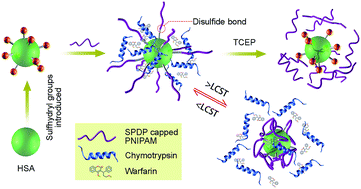Synthesis of thermo-responsive polymer–protein conjugates through disulfide bonding†
Abstract
A novel alternative was developed for the synthesis of polymer–protein conjugates with a controllable number of polymer chains. Human serum albumin (HSA), as a model protein, was grafted by poly(N-isopropyl-acrylamide) (PNIPAM) using N-succinimidyl-3-(2-pyridyldithiol) propionate as a coupling agent at room temperature in aqueous media. The influence of grafting number on the stability of the protein–polymer conjugate against the degradation of enzyme was examined, and the temperature dependent bioactivity was monitored through testing the warfarin-binding affinity. Furthermore, the protein could be recovered by incubating the conjugate under reducing conditions to cause the cleavage of the multiple disulfide bonds.


 Please wait while we load your content...
Please wait while we load your content...